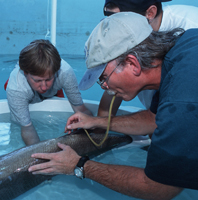AQUACULTURE STUDENT

PAUL CURTIS
What They Did Back Then
* Master of Science completed 1992, University of Guelph
Advisor: Professor Richard D. Moccia
Quality evaluation and cryopreservation of semen from Rainbow Trout (Oncorhynchus mykiss).
ABSTRACT
Rainbow Trout semen was cryopreserved in an ovian fluid (OF) based extender and embryo hatch rates were compared to those from eggs fertilized with semen cryopreserved in the extender of Stoss and Holtz (1981b). The extenders were also tested at two concentrations of the cryoprotectant DMSO ( 6.5% and 9.1%, vol:vol) and two pre-freeze equilibration times ( < 1 minute and 10 minutes). Sperm motility scores generated using a new scoring system devised for this study, were compared between treatment combinations, and correlated to hatch rates. Prior to the above tests OF and SP component levels were compared and OF was adjusted by adding potassium to inhibit sperm motility when extended in OF. Trials were also undertaken to refine fluorometric techniques used to estimate live sperm cell percentages of fresh and cryopreserved semen.
An increase in OF potassium ( to 27.4mM) was found necessary to inhibit sperm motility at semen extension. Semen extended in ovarian fluid consistently produced significantly higher egg hatch rates than did the Stoss and Holtz (SH) formula (P<0.0001). Ovarian fluid extended semen was associated with hatch rates 2.18+/- 0.38 times higher than those with SH extender at 6.5% and 9.1% DMSO respectively. Higher embryo hatch rates were observed when a DMSO concentration of 6.5% was used than with 9.1% (P<0.01) No significant differences in average motility scores were found between any treatment combinations.
There was a weak correlation between sperm motility scores and hatch rates ( r=0.37, P<0.01). The comparisons of fry growth and morphology showed no differences between fish conceived from fresh versus cryopreserved semen. Current fluorometric techniques are not suitable for cryopreserved fish semen due to the possible lethal effects or membrane permeation of ethidium bromide. Further refinement is necessary for validation of the process when using cryopreserved semen.
Where They Are Now
Paul has worked in the aquaculture field for almost 20 years and has been involved in many facets of the industry. His education was at the University of Guelph in Ontario, Canada where he achieved a Bachelors degree in Marine Biology and Masters in Fish Reproductive Physiology/Aquaculture under Prof. Richard Moccia. His work experience includes duties assisting in the start up and maintenance of the Alma Aquaculture Research Station at the University of Guelph for one year. He also spent three years in the Fish Pathology Lab at Guelph working under Dr. Hugh Ferguson where he gained a great deal of experience in clinical and diagnostic techniques for fish health management.
Over the last 12 years, Paul has been instrumental in the development of larval rearing techniques for both hybrid striped bass and white sea bass. While at Kent SeaFarms, Paul developed these techniques for hybrids by coordinating research for an NSF grant awarded to Kent. During this grant, he also gained a great deal of experience in the evaluation of egg development and the induction of spawning using hormones. Another area where his skills were used was in fish health management where he initiated basic screening and diagnostics for the Kent production facility in Mecca, CA.
At the Hubbs-SeaWorld Research Institute's Marine Fish Hatchery, he was the hatchery manager responsible for implementing and developing larval rearing techniques for white sea bass. To achieve this goal, Paul drew from all aspects of his aquaculture career. From the design of recirculating and water sterilization systems, to fish health management and nutrition for larvae, juveniles and broodstock, Paul used creativity and problem solving to make predictable production of white sea bass a reality.
From all of this experience Paul has started his own consulting company called AquaSolver LLC (www.aquasolver.com). The company has focus in hatchery development with an emphasis on larval rearing and reproductive troubleshooting. The design of recirculating aquaculture systems are also a specialty from home garden ponds to full scale hatchery systems. Another area of that is growing is the area of product development. A new product for treating disease in Koi has been launched called MinnFinn and is environmentally friendly, neutralizable and non toxic. MinnFinn went to market in February 2009 and has been doing very well in the treatment of external Koi diseases. Please see www.minnfinnmax.com. Future products include customized diets for aquarium fish and other fish health products through MinnFinn.
Currently, Paul is working on trying to
get a Southern Steelhead rescue hatchery built in San
Diego County where a native steelhead can tolerate pretty
warm water and it is threatened with all of the habitat
destruction.